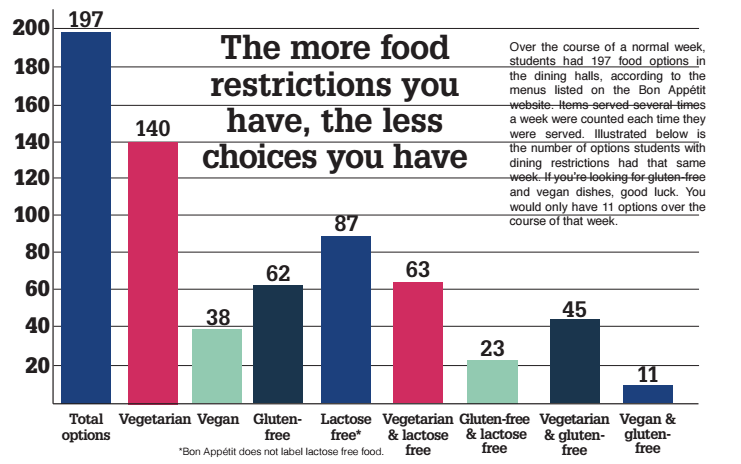A closer look at dietary restrictions in CWRU’s dining halls
Currently some gluten-free options are available in separate fridges for students.
With students paying a minimum of $5,200 each year for a meal plan, it’s crucial that they get something they enjoy eating.
According to Bon Appétit, CWRU’s food management company, approximately seven percent of the Case Western Reserve University student body deals with some kind of dietary restriction or food allergy, not including vegetarians and vegans. These students pay the same price as everyone else, but they often face limited selections when they’re trying to find something to eat.
Incoming freshmen fill out a survey during orientation that asks if they have any dietary restrictions or allergies. At this point, if the student says yes, they are “flagged” and Dayna Einheit, residential dietitian, adds them to a list. She checks up with these students at the end of each semester to make sure that they are being taken care of effectively. This year there are 166 freshmen with medical dietary restrictions.
“We know you pay a lot of money for the meal plan, and we want everyone to be able to enjoy the food,” Einheit said.
Bon Appétit also plans to implement a new food station at Fribley Commons called “The Oasis” that will be free of gluten and the top eight allergens. Over spring break, the station, now used to serve stir-fry and pasta, will be heavy-duty cleaned by an outside company. None of the food made there will be stored in the kitchen, to eliminate risk for contamination.
It will be piloted for two and a half weeks on weekdays for lunch and dinner. If successful it will be open for breakfast, lunch and dinner next year and will possibly be available at Leutner Commons as well.
“The goal is for the food to be exceptional so that students don’t realize they’re eating gluten-free food,” Einheit said.
Current options for students with celiac disease include a small section of the dining hall with a few foods. Both Fribley and Leutner’s “made without gluten” section is located near the cereal station, with Fribley also having a small cooler with a few gluten-free products. Leutner’s gluten-free selection often mimics the home table entrée.
Students with celiac disease often feel left out eating a separately cooked meal, as they want to just eat with their friends. Others feel perfectly comfortable with going to their section to get food.
“I don’t see it as a problem,” said senior David Aghassi, regarding his gluten intolerance. “I see it as how I have to live.”
The Oasis aims to bridge this gap by offering students a safe place with gluten-free food that is not so secluded.
According to Vincent Gaikens, executive chef, there is also a designated cook to make the gluten-free foods in a separate location in the kitchen.
In addition to the gluten-free options, students with dietary restrictions can also request ingredients from the head chef, such as vegetables to cook in their dorms. If they are worried about cross-contamination in the kitchen, the chef is willing to give students a few ingredients to cook with.
Furthermore if students report their allergies to the Office of Disability Resources, they could even be eligible to have microwaves and refrigerators in their rooms.
As for vegetarians and vegans, Leutner and Fribley workers try to do as much as they can to accommodate them. The cooks use separate green utensils, change their gloves and use different cutting boards for meat.

At Bag It! and Grab It!, students with dietary restrictions can work out a special plan with Einheit. Most students go to these locations on specific days in the week. With a set schedule, the chefs can prepare and send a meal to the location on those days, and the student can simply grab his or her meal.
Students with other dietary restrictions, including lactose intolerance or religious restrictions, can also ask a chef for a custom-made meal. Even when the chefs are unsure of how to accommodate a student, they often find themselves learning more about a condition. Students are always encouraged to request meals.
“Our motto is never say no, always say yes,” Gaikens said.
However, even with these options, many students still have complaints about the way that their dietary restrictions have been handled.
Adithi Iyengar, a junior who is a vegetarian and lactose intolerant, says that she does not remember ever having any communication with the residential dietician, and she was never made aware of her options as far as requesting special food.
“While I understand Bon Appétit is trying really hard to cater to all the different dietary restrictions, they don’t have many choices for people that have multiple dietary restrictions like me,” she said. “I’m stuck eating the same things again and again in small quantities. I don’t think it’s worth the money that I’m paying for to go into the dining hall.”
Students also complained about the lack of labels on the foods in Leutner and Fribley. These labels are crucial for those allergic to ingredients to know the contents of their food.
“They don’t put labels on some of the foods, and sometimes they even mislabel them, especially the desserts,” freshman Sharon Chen, who has a nut allergy, said.
Although Bon Appétit does label vegan, vegetarian and gluten-free on their website and on the signs in the dining halls, they do not label foods that contain lactose.
“There have been times where I ate copious amounts of something, didn’t realize there was heavy cream or something and got very sick,” said Iyengar.
Bon Appétit says that, while they try to label everything, it is sometimes difficult with large amounts of food.
“We try to use clue words in our food labels,” said Einheit. “We can’t label everything, but the goal is to have [students] ask questions.”


